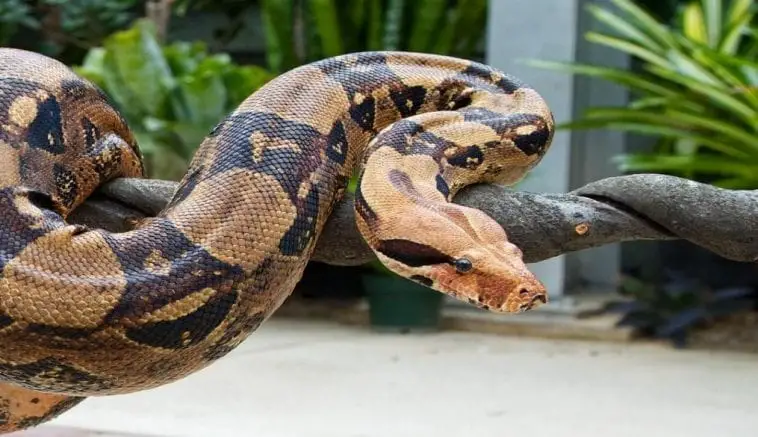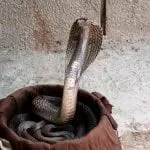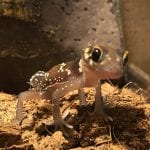Scientific Facts
| Common Name | Boa constrictor |
| Scientific Name | Boa Constrictor |
| Lifespan | 20 to 30 years or 40 years (rare) |
| Size | 6.5 to 9.8 feet |
| Habitat | Woods, rainforests |
| Country of Origin | Mexico, Central America, South America |
Physical Description
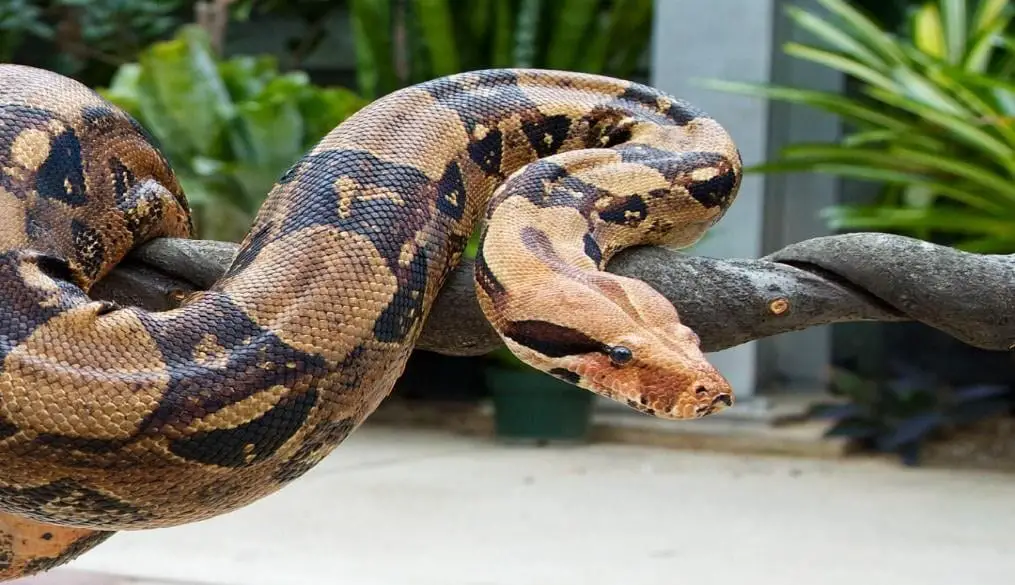
A boa constrictor has the saddle-like marks all over its body. These markings can be dark on a gray or light tan background. These saddle marks seem more prominent near its tail. The boa constrictor is smaller than the anacondas as it grows up to only 13 feet long and weighs over 100 pounds.
The head of a boa constrictor is long and triangular. The snake also has markings on its head, but the marks may from one species to another. Usually, a stripe line runs from the snout up to the back of the head.
A dark triangle is at between its snouts and eyes. This marking even continues behind its eyes, sloping down towards the snake’s jaw. A boa constrictor has spots that spread across its body at times.
Also, this snake has tiny hooked teeth used for grabbing and holding prey. If those teeth fall out or get damaged, a boa constrictor can regrow them. On the other hand, this snake does not have fangs, but its jaws can stretch widely that lets it swallow bigger prey.
While many people are afraid of a boa constrictor, this snake is less likely to attack humans. Only very few cases of biting were reported. Even the babies are too big to be prey for the snake. This animal is used in controlling rat infestations in homes in some areas in South America.
Depending on its habitat, the coloring and patterns on the skin of boa constrictor may differ. It can change colors from tan to green, yellow, or red. It will also have cryptic patterns which form jagged lines, bars, circles, and diamonds.
The bigger members of the Boidae family come with heat-sensitive pits that you will see on their heads, but a boa constrictor does not have one. Instead, this snake uses its tongue and vision to gather sensory information regarding its surroundings like the other types of snakes do.
As a nonvenomous snake, a boa constrictor can be a good choice of pet for those who love taking care of exotic animals like snakes and lizards.
Sub-Species
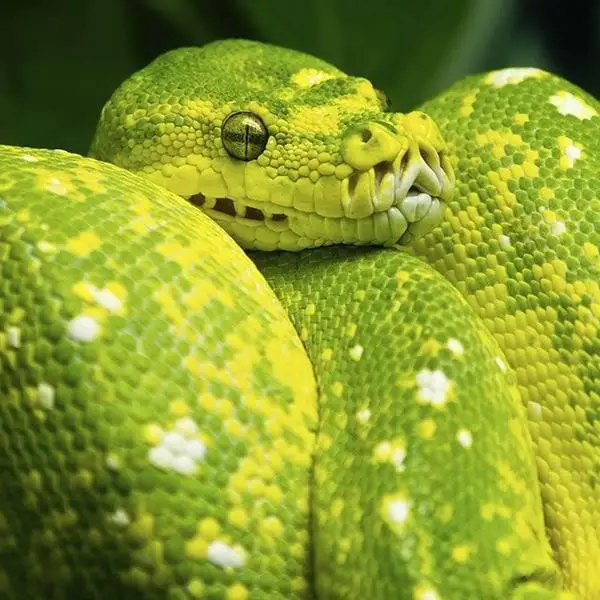
Those snakes that belong to the subfamily Boinae exist in Papua, Madagascar, the Neotropics, and Pacific Islands. The boa constrictor sub-species include:
- Arcantophis (Madagascar Ground Boa and Dumeril’s Boa)
- Boa (just one species – boa constrictor, also known as the red-tailed boa)
- Sanzinia (Madagascar tree boa)
- Corallus (Tree boas)
- Eunectes (Anacondas)
- Candoia (Pacific boa)
- Epicrates (Rainbow boa)
Subfamily Erycinae
Unlike the real boas, the snakes from this sub-family are somewhat small. Most members stay less than a meter long. The fossils were discovered in rock strata that seem to be more than 50 million years old.
The history says these snakes used to be widely available in North America. Today, there are just two species left in the area, including the sand boas that are more common in southeastern Europe, Africa, and Asia.
3 species can lay eggs:
- The Calabar Boa which used to be categorized as a python
- The Arabian Sand Boa
- The West African Sand Boa
The sub-species from this family include:
- Gongylophis (the rough-tailed Sand Boa)
- Eryx (Sand boa)
- Charina (Rubber boa)
- Calabarinae (Calabar Python – occasionally equates with Charina)
- Lichanura (Rosy boa – occasionally equates with Charina)
Appearance Differences Between Each Species
Boa is a primitive snake like the python. It comes with vestigial remnants in the pelvis and hind limbs similar to its lizard-like predecessor. The little cloacal spurs on the sides of the vent are connected to the vestigial limbs.
A boa constrictor has varied and distinctive marks. Depending on its habitat, the snake can be in a specific color that helps it hide against a predator. Also, the tail of this snake has blotches coupled with scale patterns that can be ovals, diamonds, leaves, and circles. Depending on the sub-species, a boa constrictor can have a variety when it comes to appearance.
Common Boas
The common boa has below 253 ventral scales on the belly surface and 21 dorsal blotches in between the neck and vent. This type of boa constrictor does not have a speckled belly. If it does, it will be lightly speckled while the pattern on its tail looks smudged. Breeders created a variety of colors and patterns. The most popular variant is the scarlet blood phase boa.
Red-Tailed Boa
It is the most famous subspecies of the boa constrictor. It has 234 to 250 ventral scales and blotches. This species has a black, speckled belly and well-defined red blotches on its tail and posterior. It is also the biggest subspecies of boa constrictor and is arguably the prettiest kind.
Short-Tailed Boa
A short-tailed boa has more ventral scales ranging from 226 to 237. It also comes with 22 dorsal blotches and a dark, heavily speckled belly. The snake also has a flatter-looking head and the background color ranging from silver and gray to rich and dusky yellow.
Peruvian Black-Tailed Boa
It’s a distinct morph, a variety made by breeders and is not available in the woods. This variant has a wide and central stripe on the head and black frontal and posterior face marks. It also comes with a dark interconnected saddling on the background shade that can vary from light powder-gray to yellow-brown with more black shades all over. Both the tail blotches and posterior body are black.
Argentine Boa Constrictor
This species has between 242 to 251 ventral scales and 29 or 30 interconnected dorsal blotches. Also, it comes with white and black peppering.
Lifespan
A boa constrictor is one of the longest-lived snakes in the whole world. It’s normal for every boa constrictor to live for 20 to 30 years. It can even live for up to 40 years, though that happens in a very rare case. The oldest boa constrictor lived for up to 43 years in the Philadelphia Zoological Gardens.
Camouflage
The eye-catchy patterns and marks on its body which help the boa hide and assimilate with the environment. The markings on its skin can be in shapes like diamonds, circles, or ovals. Their skin can be green, yellow, tan, or red. These colors and shapes allow the boa constrictor to stay invisible to prey and enemies.
Behaviors and Habits
Compared to its anaconda cousins, the boa constrictor is a good swimmer. However, it loves to remain in a dry area despite having that ability. It lives mostly in the hollow logs and uninhibited mammal burrows.
The boa constrictor likes to hang around. In the forest, it usually spends its time getting itself tangled from the tree branches. As a pet, it enjoys curling up on the tough branches you put in his cage.
The snake appreciates a perch and the inverted wooden box forms an extra level to ascent. The hollow log gives the snake the space for comfort and privacy. If you give it a good habitat, he’ll slither all over and explore the area.
Also, the boa constrictor is nocturnal. It frequently coils up throughout the day in a hot and sunny spot and hangs lazily from a twig. When the day is over, it becomes active and crawls around his cage and looks for prey.
Like other snakes, a boa constrictor loves meat. It does not have fangs and venom to use in killing the prey. Instead, it strikes at its victim, catches it using those sharp teeth, and coils up tightly to the victim’s body.
When the prey dies, the boa swallows it entirely. Rats, mice, birds, and other tiny mammals are the most common victims of a boa constrictor. Just put one in the cage of your pet and leave the rest to it.
You can also give frozen prey to the snake, which you can easily buy in a pet shop or online supplies store. Though the prey is lifeless, still the boa constricts its food before ingesting it.
You will see the snake’s midsection bulged as it digests the food. This process may last for up to 6 days. The snake will not be willing to eat again for the next 7 days.
Habitat
The boa constrictor prefers to live in the tropical climates of the rainforests. However, it can also endure various conditions, including tropics and arid deserts. It varies between species.
Diet
A boa constrictor is a meat-eater. It loves to ingest fresh and live prey. You can feed this snake once every week to twice every month. It depends on the age of your pet. The baby snake grows faster than the adults, so you need to feed it more often.
One thing you must keep in mind when feeding a boa constrictor is the prey must be smaller than the broadest section of its body. The snake can consume pre-killed prey like mice and rats. When feeding your pet, don’t forget to give it a bowl of clean water.
As a golden rule, the younger boa constrictor needs frequent feeding compared to an adult snake. You can feed a smaller snake every 5-7 days. The intermediate-sized snake needs to be fed every 10-14 days while the full-grown one needs the same thing every 3-4 weeks.
Adjust the feeding schedule to keep your pet healthy and happy.
Always remember that most boas in detention are overfed, which leads to obesity issues. Hatchlings can be fed with rabbits and mice (only one each time you feed it). The adult boa will consume a few rats for one meal or a rabbit per month.
Don’t feed a boa constrictor anything bigger than the widest part of its body. Never touch the snake within the next 24 hours after you fed it, or else vomiting will take place.
Usually, the boa constrictor hides with the prey to ingest it. So, expect that your snake will disappear into its hide box with its food. That may take a while.
If you have two boa constrictors, feed them in two enclosures apart from their cage. This way, they can associate feeding with that space. Do it if there’s an opportunity.
Feeding time will be the most demanding part of taking care of a boa constrictor as a pet. Don’t feed the snake using your hand as it may cause your pet to bite you accidentally. After giving the food, wash carefully your hands or else the snake may see your hand as food and bite it.
You can use a handling stick in pushing your pet away from the cage’s door when feeding it. This is a simple trick that can solve problems.
When feeding live prey to your snake, just watch it and take prey away if the snake is not hungry. A terrified prey may claw or scratch the boa, which leads to infection and injury.
If you have two or more snakes, just feed one of them per enclosure. Do it one at a time to prevent injury both to yourself and other snakes.
“Power feed” is a typical feeding practice used by most snake owners. In this practice, you are going to feed the snake with huge amounts of food at a young age. The notion here is tapering off the amounts of meat given as the snake grows, leading to the optimal size.
On the other hand, power feeding is not advisable or even good for a boa constrictor. This type of snake tends to take more time to grow. Also, its body takes longer to metabolize the ingested food compared to other snakes.
Overfeeding it can lead to digestive issues, vomiting, and obesity. These problems are more likely to occur in Red-Tailed and Argentine Boas.
Constricting
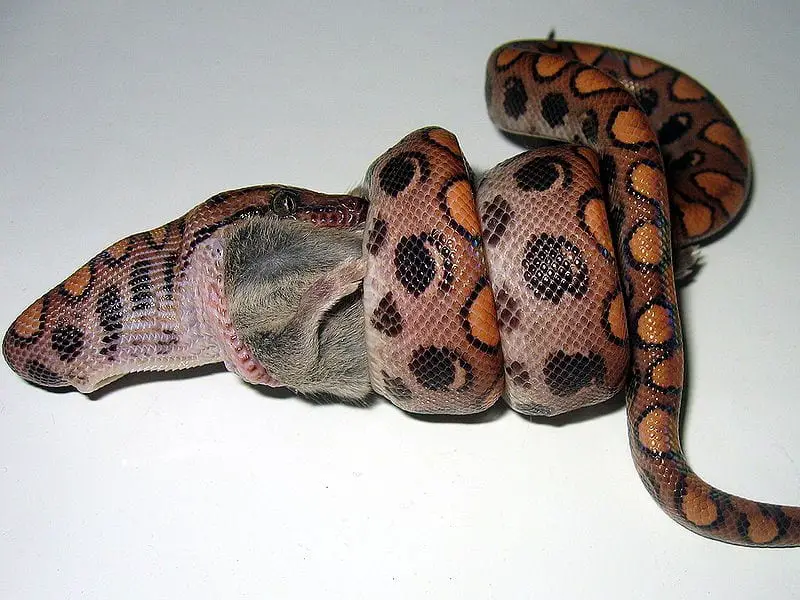
Possibly, the most popular characteristic of a boa constrictor is its ability to kill prey. Since it does not have fangs and venom, it relies on its strength to constrict and squeeze its victim to death. However, there are misconceptions associated with constricting and how it works.
One of the misconceptions is that a boa constrictor crushes or breaks the bones of its victim. Another thing is that the snake suffocates the victim and squeezes the lungs to kill it.
A study about constricting revealed that squeezing affects the circulatory system. In that case, the blood will not be able to reach the brain, so the prey will die in seconds because of ischemia. When the victim dies, that is only when the snake will ingest it.
Its Role in the Ecosystem
Snakes like the boa constrictor also play a crucial role in the ecosystem. It acts as a predator on the small mammals and birds including the bats. Also, the boa constrictor acts as a vital predator of opossums and rodents that can turn into pests in certain areas. They can even become carriers of diseases like leptospirosis.
Shedding
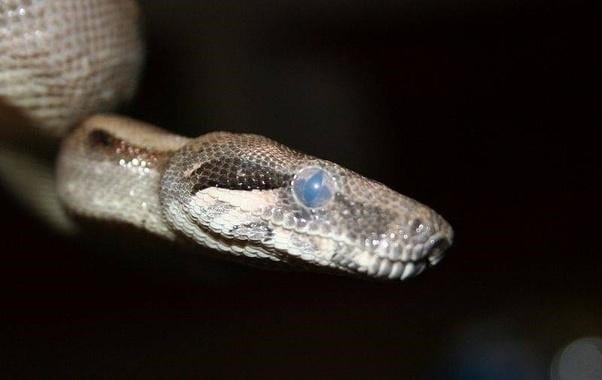
As the boa ages, it outgrows its old skin, leaving it behind. This process is known as shedding that provides the snake new and healthy scales. If the snake’s shiny tan scales look cloudy and his eyes become milky, those are signs that shedding will take place.
The cloudy look of the scales is the result of the lubricating material which exists between the old and new skin. You will even see this in the eyes of a boa that inhibits his vision.
The boa will lay low throughout the shedding process that can take days. It becomes more active once the process ends. At the same time, the snake will regain its sharp eyesight. Shedding occurs more often than the adult snake.
Substrate
You can use a wide range of substrates for the boa constrictor cage. If the snake is young, you can line the cage with paper towels or paper for easy cleaning. For an adult snake, you can also use paper as a good indoor or outdoor carpeting.
The advantage of carpeting is that you can cut 2 or more species to fit easily the enclosure. You can replace the soiled one with the extra sheet while cleaning and sanitizing the stained piece. You can use a reptile bark, too – if you have a bigger budget.
Don’t use wood shavings. It can cause irritation and is more likely to cause accidental ingestion or impaction. A clean, sterilized tree branch is heavy and strong enough to support the weight of a growing snake. Just immerse it in the bleach solution, wash it well, and dry thoroughly before putting it inside the cage. The store-bought driftwood is also advisable.
Temperature
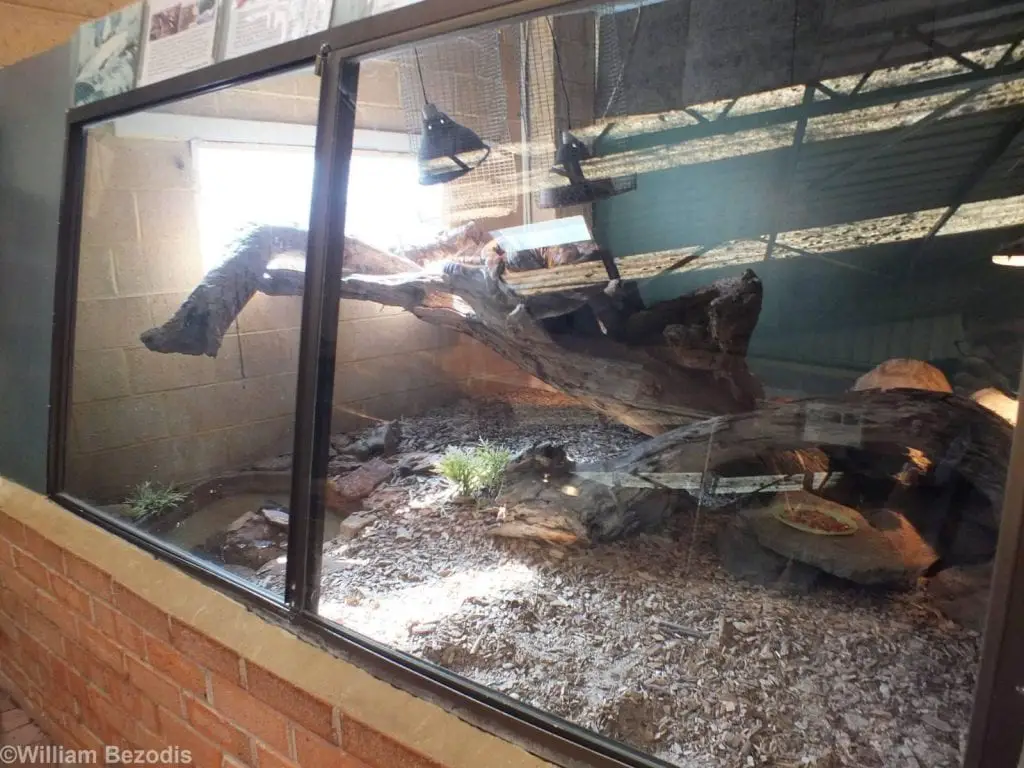
The boa constrictor can’t regulate its body temperature. The snake needs external heat sources as it cannot regulate its body temperature. In the forest, it uses the sun for the same purpose. When taking care of a boa constrictor, you must maintain the adequate temperature in the habitat of your pet.
The snake should be able to move from cooler to warmer parts of the enclosure. In the daytime, the temperature of the habitat’s main part must be anywhere between 80 and 85 degrees Fahrenheit with the basking space of around 95 degrees. Nighttime temperatures must be between 75 and 80 degrees Fahrenheit.
You can make the snake’s habitat warm and maintain the ideal temperature in many ways. You can heat the enclosure by using heat lamps, heating pads, and ceramic emitters. Mount the ceramic emitters and heat lamps above the enclosure to direct the warmth down. You can put adhesive pads or heat tape on the base of the glass insertion.
Lighting
The boa constrictor does not need UV light to sustain its health. However, you can use a light if you like. If that is your preference, then use a full-spectrum light or low-wattage incandescent bulb throughout the day. Put the light away from the snake. Physical contact with the light can use serious burns to the animal.
Reproduction
A young boa constrictor is ready for mating in the next 3 to 4 years of its life. The mating season for this snake species happens during the rainy period. The male snake will slide across the female to stimulate the cloaca with its vestigial legs.
Then, the female snake will give birth to live and independent babies. The young snakes will often spend their time in the trees as they grow to be large and heavy. Adults will stay mostly on the ground. Every boa constrictor reaches the sexual maturity at the age of 2 to 3.
The boa constrictor is ovoviviparous. Meaning, it gives birth to fully-formed baby snakes. The female snake will eat very little throughout the gestation time that will last for around 100 days. Once the eggs reach the right time for delivery, they will push out the cloaca and break the protective film that encapsulates them. The newborn snakes are around 20 inches long and may grow up to 3 feet in the next several months. The young snakes are independent as they survive alone. They can even show natural instincts for camouflage and hunting.
Distribution
The boa constrictor is a native of Central America, South America, and in some parts of the Caribbean Islands. It seems to have fun with the spots with a good natural cover and increased humidity. The snake is highly adaptable, so it can live well in other parts of the world, such as in Asia.
Common Health Problems of a Boa Constrictor
Whatever kind of pet you have, be it a mammal or reptile, it has no exceptions when it comes to health concerns. Here are the most common diseases that a boa constrictor may incur:
Inclusion Body Disease
While the boa constrictor is naturally healthy and though animal, it remains vulnerable to a severe disease called Inclusion Body Disease or IBD. It is as worse and life-threatening as AIDS in people. An infected snake cannot transfer the disease to humans.
The boa constrictor is known to be the number one carrier of IBD. However, the disease is hard to detect the disease in the animal as it can stay dormant for months and even years.
If you have any other snake other than the boa, avoid keeping them all in just one enclosure to prevent the disease from spreading. As of now, experts believe that IBD does not affect any other snakes.
The transmission of the disease can take place when the boa constrictor has mites. Those mites will be infected as well and may transfer the disease to other snakes during cohabitation or breeding. The best preventative measure for it will be to keep your snakes in separate cages.
A boa constrictor might have IBD if it manifests any of the following symptoms:
- The snake breathes while keeping its mouth open.
- The snake excretes too much saliva. The saliva looks thick.
- The animal has a poor appetite.
The signs of IBD at the early phase can be the same the symptoms of a more common reptile respiratory infection. Thus, it is necessary to seek help from a registered herp veterinarian right away once you see any signs of IBD in your pet.
In the advantage phases of IBD, the snake may become unable to control its moves and show the contoured look called stargazing syndrome. In this condition, the boa constrictor seems to be moving and looking upside down.
Respiratory Infections
Aside from the IBD, the boa constrictor is also very susceptible to respiratory diseases. The good thing is that most of these diseases are due to insufficient heat ingredients and bad husbandry practices. Therefore, the respiratory infections in a boa constrictor are easier to treat.
If your pet wheezes while it breathes or shows any other symptoms of a respiratory disease like keeping its head upward for too long, check the temperature inside the enclosure. At times, adding more heat to it treats a respiratory disease in the snake. However, seeking professional help is advisable when your pet experiences nasal discharge, labored breathing, and poor appetite.
When a boa constrictor suffers from a more advanced case of pneumonia, the animal may excrete a foamy and cheese-like substance through its mouth. Take the snake to a veterinarian as soon as you see this secretion.
Scale Rot and Blister Disease
These two health conditions often come together. Like the respiratory infections, they can also be due to deficient husbandry practices.
Excessive heat or insufficient humidity can be the main culprit of the blistering disease. On the other hand, the scale rot is the result of a failing immune system.
The scale infections in a boa constrictor can have different signs that range in severity. There can be a mild case of hemorrhage or severe ulceration and blistering. In a worse case, the snake may seem to have chemical burns that can take two weeks or more to heal. If your pet has a possible skin disease, don’t waste your time – bring it immediately to a reptile veterinarian.
Possible Danger to Humans
There’s a minimal negative impact of boa constrictor on humans. This snake can attack a person, but it happens so rarely. A boa constrictor may likely do that as a way of protecting itself against violence. In its eyes, both adults and kids can’t become food. As said before, this snake cannot take bigger than the size of the widest portion of its body. Thus, the snake settles for little mammals and birds.
The bites of a boa constrictor can be painful but not dangerous in the first place considering that this snake is nonvenomous. The bites can become a big problem only when the victim does not seek proper medical care and assistance.
A huge captive snake should be handled with the utmost care, especially when feeding it. That’s because a starving snake strikes and tightens in a mostly automatic order of behaviors. A bigger snake must be fed and handled with 3 or more persons.
Choosing Your Boa Constrictor
The boa constrictor is a good pet. It is naturally calm, though not so sociable. It is also capable of showing affection to its owner, just like what a cat or dog can do.
Taking care of a boa constrictor is a lifetime commitment as the snake can last for decades. If you have decided to own one, then you need to consider some factors that can help you choose the right boa to have as a pet. A healthy snake shows the following signs:
- Well-rounded body
- Firm skin
- Good muscle tone
- Clear eyes
- The animal seems alert
- Flicks its tongue to check the environment
- Grips your arm when you touch the snake
Where to Get One?
You can get your boa constrictor in pet shops, online reptile shops, and professional breeders. Some wild-caught snakes can be adopted as pets, but the captive-bred ones are better choices as they have nice patterns or color morphs.
How to Care for a Boa Constrictor as a Pet?
Owning this snake is a big responsibility. The snake can grow to about 9 feet long and weigh 60 pounds throughout its lifetime. If you’re ready for that type of commitment, then expect that your baby snake will need specialized care to keep it healthy and happy for the rest of its life.
Avoid the wild-caught boa constrictor as it can be less docile compared to the ones from pet shops or breeders. A wild-caught snake can even be weak and sick.
Once you have the snake, provide everything it needs – food, lighting to keep it warm, substrate, and a good cage. Find out if there is any special care needed depending on the kind of boa constrictor you have preferred. When shopping for the required accessories, check carefully the items especially the enclosure. Make sure it is clean and good enough for one snake.
In keeping the snake in good condition, always check it for mites around its eyes, injuries, or any buildup or gunk in its mouth. Also, watch out for the signs of those diseases mentioned above.
Lastly, learn how the animal responds to touch. If your pet seems fearful, ask for assistance from a professional breeder.
Fun Facts About Boa Constrictor
- A female boa constrictor is bigger than the male.
- The snake’s scientific name is simply boa constrictor. It’s rare for an animal to have the same common name and scientific name.
- The boa constrictor is a member of the Boidae Family. This group is also called “boas”.
- This snake is also a member of the Boinae subfamily. The green anaconda is also part of this subfamily. Meaning, the boa constrictor, and green anaconda are closely related.
- The boa constrictor can be delivered without the skin pigment. This condition is known as albinism that can occur as well in humans.
- The bite of this snake is painful but never fatal.
- The boa constrictor hisses when threatened or irritated.
- The snake can live for up to 30 years or even 40 years.
- People hunt the boa constrictor for its meat and skin. The snake is food for the indigenous people. Despite that, the boa constrictor is not classified as an endangered species.
- People have been using this snake to control the population of mice and rats.
- The biggest boa constrictor was 5.5 meters or 15 feet long.
FAQs
Are boa constrictors friendly?
The boa constrictors may not be a friendly snake in nature, but you can make them moderately sociable with daily contact and gentle handling. It makes them great companions in the comfort of your home.
Does the boa constrictor like to be touched and handled?
The boa constrictor likes gentle handling. With regular handling, the snake will become tame and appreciate your caring hands.
Can a boa constrictor swim?
Yes, a boa constrictor can swim though it cannot move so fast even in the open ground – just around a mile per hour. Although the boa constrictor can swim, it usually spends more of its time out of the water.
How often does the boa constrictor eat?
The boa constrictor may eat more or less, depending on its age – babies eat more than the adults. You can give food to it once in a week or twice every month.
How often does a boa constrictor poop?
A boa constrictor may defecate within the week you fed it, but it happens every 2 to 3 weeks. In some cases, the snake poops in 2 to 3 months after its last meal.
What can I feed my boa constrictor?
You can feed a boa constrictor with small to medium-sized birds and mammals. Its diet often consists of rats, but it may also include mammals, lizards, and even something bigger like the ocelots.
Does the boa constrictor have fangs?
The boa constrictor does not have fangs but with sharp teeth. However, their jaws stretch a lot so that they can ingest a big prey.

